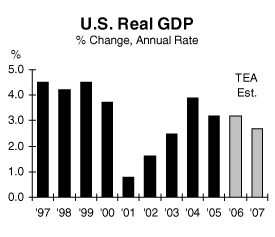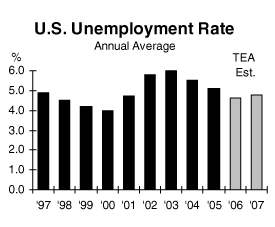|
December 13, 2006
Outlook 2007
Written by Jeff Thredgold, CSP, President, Thredgold Economic Associates
The U.S. Economy
…more moderate growth
The solid 3.5% real (inflation adjusted) annual growth rate since 2004 should give way to a 2.5%-2.8% real growth pace in 2007. At year-end 2006, the current expansion (which officially began in November 2001) is about to enter its 63rd month. We don’t subscribe to the recession view pushed by some, although odds of a recession have risen slightly.
The Federal Budget
…less red ink
Sharply higher corporate and individual tax receipts reduced the budget deficit for fiscal year (FY) 2006, which ended on September 30, to $248 billion. This compares to the $318 billion shortfall in FY2005 and the record $412 billion shortfall in FY2004. However, budget issues become more challenging in coming years.
Employment
…small business gains
The nation’s unemployment rate averaged 4.6% during 2006’s first 11 months. By comparison, the jobless rate averaged 5.3% in 2004/05 and 5.9% in 2002/03. Monthly job gains have slowed somewhat. We expect the unemployment rate to average just under 5.0% in 2007.
Net job creation via the “official” survey of 375,000 medium- and large-sized businesses has been modest during the past 60 months, with the addition of 5.1 million new jobs. The “other” employment measure, the household survey, has recorded nearly twice as many new jobs, an indication that small business job growth remains strong.
Inflation
…more market friendly
Declines in energy prices have sharply reduced inflation pressures in recent months. For instance? The Consumer Price Index (CPI) from June 2005 to June 2006 rose 4.3%. The 12-month period of October 2005 to October 2006 saw the CPI rise only 1.3%. Overall consumer prices are expected to climb 2.7%-3.2% in 2006. By comparison, consumer prices rose 3.4% in 2005, 3.3% in 2004, and 1.9% in 2003. Most forecasters see 2007 consumer inflation closer to 2.5%.
The Federal Reserve
…on the sidelines
The Federal Reserve has been “on hold” over the past five months, following 17 consecutive 0.25% hikes (to 5.25%) in the critical federal funds rate between June 2004 and June 2006. Prior to that period, the federal funds rate was at a 46-year low of 1.00% for 12 months.
The Fed’s next Open Market Committee (FOMC) meeting is January 30/31, with no change likely. A further move to 5.50% is possible in coming months, although unlikely. Most forecasters expect the Fed to remain on hold through 2007’s first few months, with a move or two (or three) to the downside around mid-year 2007.
Long-Term Interest Rates
…recently trending lower
Mortgage rates were at 10-month lows near 6.125% in recent days, before moving slightly higher last Friday. Such rates reached 4-year highs in June/July. I would suggest that mortgage rates have peaked for this cycle, with rates possibly moving to “the very high 5s” by mid-year 2007.
Home Prices
…pain of excess
Surging home prices on both coasts and in the Southwest gave way to a buyers’ market in 2006’s second half. The simple reason? Home owners and “flippers” simply pushed prices too far over the past five years, requiring the current painful downward adjustment. We expect greater home price strength in the nation’s interior as relative values (compared to the coasts) are cheap.
The Global Economy
…impressive growth continues
Solid global economic growth is expected in 2007, following impressive growth during the prior four years. Solid growth for 4-5 straight years would be the first such occurrence since the early 1970s. As before, risks to this view include any major new terrorist atrocities (especially on American soil), much higher oil prices, and a worsening of Middle East tensions.
Any discussion of the Pacific Rim must begin with Japan, a nation that still accounts for more than half of all Asian economic output and still ranks as the world’s second largest. Japan returned to modest economic growth during the past 36 months…following “the lost decade” of economic stagnation. Rising exports to China and stronger consumer spending have benefited the Japanese economy. The eight-year battle with deflation has given way to extremely low inflation.
Chinese real economic growth has averaged near 9.0% for 26 years (although from a very low base), the longest sustained growth for a major nation on record. Of major concern? Powerful economic growth has led to serious environmental damage, with polluted air in major cities and poisoned rivers the norm. A “green movement” in China is underway.
India’s economy continues to perform well, although an infrastructure of two-lane national highways and antiquated airports, sewers, & water systems must be addressed. Most other economies in the Pacific Rim are performing reasonably well.
The European economy has strengthened, with real growth near 2.3%, the best in six years. Kingpins Germany and France still struggle with jobless rates near 11.0% and 9.0%, respectively. The European Central Bank has raised its key short-term interest rate numerous times since last fall to keep inflation at bay. Additional hikes could occur in 2007.
The Russian economy continues to take advantage of solid oil prices and high oil production, with Russian oil exports now second only to the Saudis. Europeans are leery of interruptions to Russian natural gas supplies this winter as President Putin uses this new “weapon” to his advantage.
The South American economy has slowed somewhat. Oil-rich Venezuela remains a political powder keg, with production now in decline. Venezuela’s Castro-wannabe Chavez will continue to push an anti-America agenda to whomever might listen.
Canadian economic growth has slowed, although the energy-rich Western provinces are booming. Recent unemployment rates in the “low 6s” are at a 30-year low. The Mexican economy is growing at a reasonable clip, with national political tensions at sky-high levels following a bitter Presidential election, where both major candidates still claim victory.
The Bottom Line?
U.S. economic growth during the past 36 months has been solid. Stable growth is likely to continue. In addition, we expect: another 12-digit budget imbalance…slowing employment gains…modest inflation pressures…relative stability in both short- and long-term interest rates…soft coastal housing markets, with more solid interior performance…and an anxious but impressive global marketplace.

“Tea”ser
My parents only had one argument in forty-five years. It lasted forty-three years.
|

